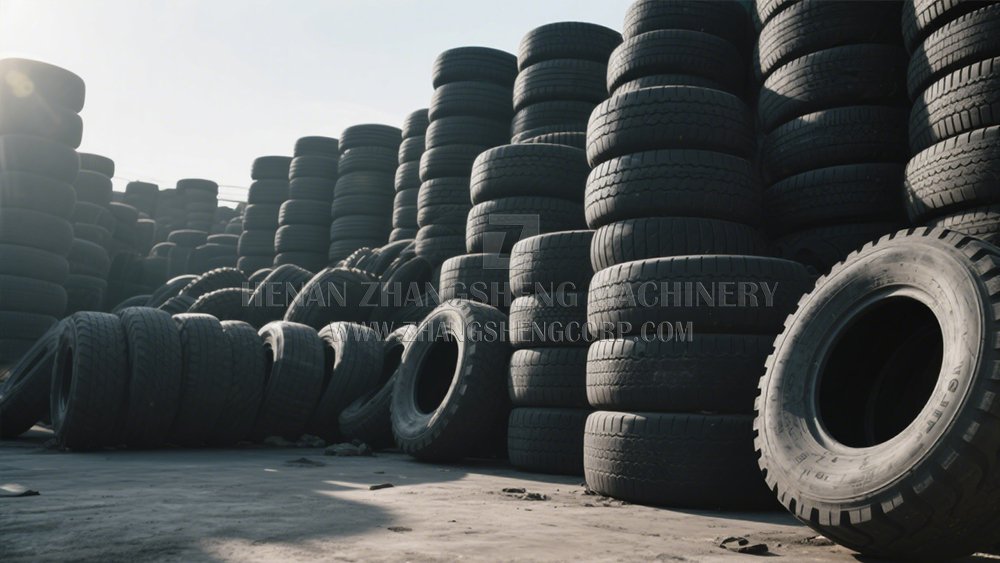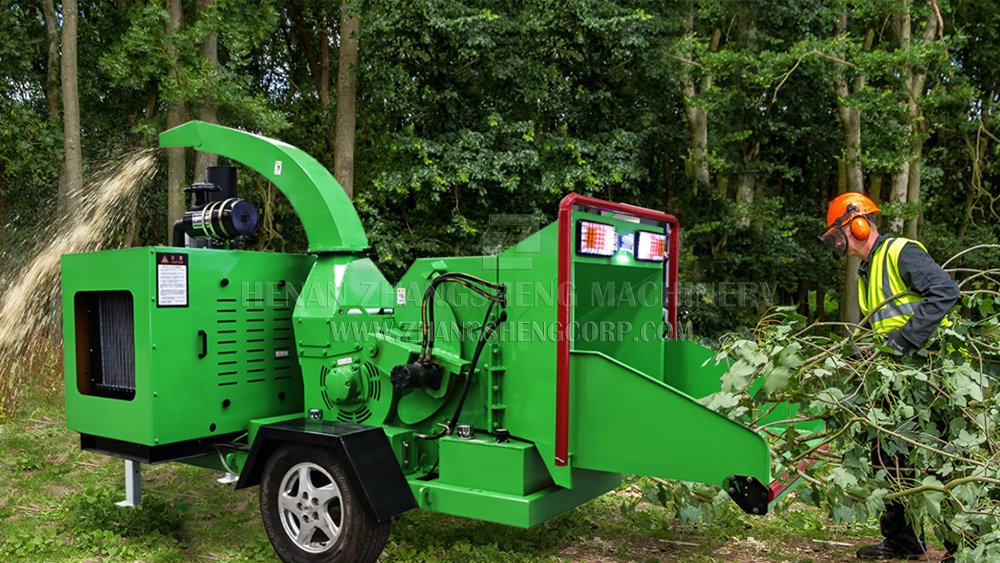You are looking for a way to create a safe and resilient surface for your horse arena, and shredding old rubber tires seems like a great idea. But is your wood chipper the right tool for this very specific job? This is a question I hear sometimes, and it is an important one.
No, you cannot shred rubber tires in a wood chipper for a horse arena. Wood chippers are specifically designed to process organic, fibrous materials like wood and branches, not dense, elastic, and abrasive materials like rubber tires. Attempting to chip rubber in a wood chipper will likely damage the machine and will not produce suitable material.
Having worked at Zhangsheng for 22 years, specializing in wood processing machinery, I have a deep understanding of what our chippers are built to do. While they are incredibly powerful for wood, rubber is a completely different material. Let me explain why this approach simply will not work and what you should consider instead.
Can you put rubber in a wood chipper?
You might think that if a machine can tear through tough wood, it can handle rubber. It is a common thought, especially when you have a lot of tires and want to repurpose them. But is it really safe or effective to try and chip rubber with equipment made for wood?
No, you cannot put rubber, especially rubber tires, into a wood chipper. Wood chippers are engineered with blades and mechanisms specifically optimized for chipping wood. Rubber is a non-fibrous, elastic, and often abrasive material that will not chip efficiently and can severely damage the chipper's components.
At Zhangsheng, our wood chippers, such as those with cutting drum diameters from Φ300mm to Φ800mm and rotation speeds up to 2800 rpm , are designed with sharp, high-speed blades (e.g., 4 to 9 blades ) to cut and shear wood fibers. Wood has a grain and a cellular structure that allows it to be cleanly cut and broken down into chips. Rubber, on the other hand, is elastic and tough. When you try to feed rubber into a wood chipper, instead of being cut, it tends to stretch, bind, and tear unevenly. This puts immense strain on the chipper's engine and cutting drum. The blades, which are hardened for wood, can be dulled, chipped, or even broken by the abrasion and impact of rubber. I recall a customer who once tried to put a piece of heavy rubber conveyor belt into his chipper; the machine immediately jammed, and he found the blades had significant damage. The hydraulic forced feeder and intelligent feeding systems on our chippers are designed to pull in and manage wood efficiently, not to overcome the resistance of rubber. Rubber can also wrap around the drum or feed rollers, causing severe clogs that are difficult and dangerous to clear. Furthermore, the heat generated from the friction of rubber against the blades and internal components can be a fire hazard.

Why Wood Chippers Fail with Rubber
| Characteristic | Wood Chipper Design for Wood | Problem with Rubber |
|---|---|---|
| Material Type | Fibrous, cellular structure that cuts and shears. | Elastic, non-fibrous; stretches and tears, does not cut cleanly. |
| Blade Action | High-speed cutting blades optimized for wood grain . | Rubber dulls, chips, or breaks blades due to elasticity and abrasion. |
| Feeding | Designed for consistent feed of rigid wood pieces . | Rubber binds, wraps around components, causing jams and strain. |
| Output | Produces consistent wood chips . | Produces irregular, shredded rubber that can be stringy and unsafe. |
| Heat/Safety | Minimal heat generation during wood chipping. | High friction, potential for overheating, fire, and dangerous projectiles. |
In short, a wood chipper is simply not the right tool for rubber.
What is the best way to shred rubber?
Since a wood chipper is out of the question, you are still left with the problem of needing shredded rubber for your horse arena. This is a common need, especially for specialized applications. So, if not a wood chipper, what kind of equipment is designed to process rubber effectively?
The best way to shred rubber, particularly tires, is by using specialized industrial shredders, granulators, or cryogenic systems designed specifically for rubber processing. These machines utilize high-torque, low-speed shredding mechanisms or grinding processes that are capable of breaking down the tough, elastic material of rubber into usable crumbs or chips.
When I speak with customers who work with materials beyond wood, like those in Waste Management & Recycling Centers who handle varied waste streams, I always emphasize that material dictates the machine. For rubber tires, you need equipment built for their unique properties. Industrial tire shredders use powerful rotating blades (often multi-shaft designs) that slowly tear and rip the tires apart with immense torque, rather than fast-shearing like a wood chipper. These machines are built with much stronger components, including hardened steel blades that can withstand the abrasion of steel belts and the elasticity of rubber. Following the initial shredding into larger chunks, the rubber often goes into a granulator. Granulators use precision cutting to reduce the rubber to smaller, more uniform crumb sizes, which is ideal for applications like horse arena footing or playground surfaces. Some advanced systems even use cryogenic shredding, where tires are frozen with liquid nitrogen, making them brittle enough to be shattered into small pieces. These processes are designed to handle the steel reinforcement found in tires, separating it from the rubber. My experience over 22 years has taught me that using the right tool for the job is not just about efficiency, it is about safety and achieving the desired outcome. For rubber, that means seeking out dedicated rubber shredding or recycling facilities.
Dedicated Rubber Shredding Technologies
| Technology Type | How It Works | Typical Output |
|---|---|---|
| Industrial Shredders | High-torque, low-speed rotating blades rip and tear material. | Large to medium rubber pieces (shreds). |
| Granulators | Precision cutters reduce shredded rubber to smaller, uniform particles. | Crumb rubber (fine particles, ideal for arenas). |
| Cryogenic Shredding | Freezes rubber with liquid nitrogen, then shatters it. | Very fine, uniform rubber particles. |
| Raspers/Grinders | Further refine shredded rubber through grinding. | Fine crumb rubber. |
These specialized machines are the only viable options for processing rubber tires.

What not to put in a wood chipper?
You now understand that rubber is a definite no-go for your wood chipper. But what else should you be careful about? Knowing the limitations of your machine is crucial for its longevity and your safety. What other materials are simply not meant for a wood chipper?
You should never put anything other than organic, untreated wood and branches into a wood chipper. This specifically includes materials like metal, rocks, plastic, glass, large quantities of dirt or mud, treated lumber (for certain uses), and fibrous materials that can wrap around components, such as rubber, vines, or excessively long ropes.
As a representative of Zhangsheng, a company that builds robust wood chippers, I always emphasize strict adherence to material guidelines. Our machines are designed with specific components for processing wood. For instance, the cutting drum has a high rotation speed (e.g., up to 2800 rpm , 2200 rpm ) and blades (e.g., 4 to 9 blades ) optimized for shearing and impacting wood. When you feed metal, like nails, bolts, or rebar, into the chipper, it will dull, chip, or break the blades and can cause severe damage to the drum itself. Rocks or concrete will do the same, often leading to dangerous projectile ejection. Plastic and glass will not chip; they will shatter, creating hazardous sharp shards, or melt and wrap around moving parts, causing severe jams. I have seen how trying to chip non-wood items can lead to costly repairs and even injuries. Even organic materials like excessive amounts of dirt or mud on roots can prematurely dull blades and clog the chipper. While our chippers have intelligent feeding systems that can sense overload and prevent jams, they are not designed to process these unsuitable materials safely or effectively. Always check your material carefully before feeding it into the chipper. For furniture manufacturers and demolition companies, for example, it is critical to remove all hardware from wood before chipping.
Unsuitable Materials for Wood Chippers
| Material Category | Specific Examples | Reason to Avoid |
|---|---|---|
| Non-Organic Hard Items | Rocks, gravel, concrete, bricks, ceramics | Damages blades, causes dangerous projectiles, catastrophic failure. |
| Metal | Nails (large), screws, rebar, wire, tools | Damages blades, risk of sparks and fire, dangerous projectiles. |
| Plastic/Rubber | Hoses, plastic bottles, tarps, rubber tires, rubber mats | Does not chip, wraps, melts, causes severe jams, fire hazard. |
| Excessively Wet/Soiled | Mud-covered roots, waterlogged wood with heavy soil | Clogs chipper, dulls blades quickly, reduces efficiency. |
| Stringy/Tangled | Long vines, rope, fabric | Can wrap around feed rollers and drum, causing severe jams. |
| Treated Wood (for certain uses) | Pressure-treated wood, painted wood (check local rules) | Can release toxic chemicals when chipped, not suitable for mulch/compost. |
| Oversized Material | Branches larger than specified inlet size | Causes jams, strains engine, can damage feed mechanism. |
Sticking to wood only will ensure your chipper remains safe and operational.
Conclusion
Shredding rubber tires in a wood chipper is not feasible or safe, as these machines are designed exclusively for wood. Specialized industrial shredders are required for rubber. Always avoid putting non-wood materials, including rubber, metal, and rocks, into a wood chipper to prevent damage and ensure safety.


